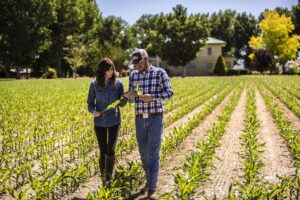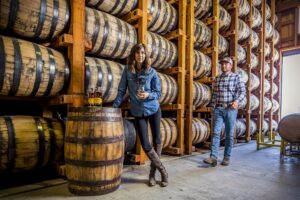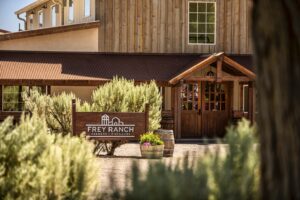By Kurt Maitland
I was able to speak to Frey Ranch Whiskey Farm and Distillery co-founders Colby and Ashley Frey about the amazing farm to glass whiskey they are making at Frey Ranch in Nevada.
KM: Please tell us the story of Frey Ranch before their entry into distilling.
The Freys: In 1944, Colby’s grandfather bought the piece of land where Frey Ranch Distillery currently sits, which also doubles as the Frey family home. However, the Frey family has a long lineage of farming here in Northern Nevada that dates back to the 1850s, making Colby the fifth generation to farm land in this region.
When Colby’s dad took over the farm in the early eighties, he taught Colby the ins plus outs of farm life, instilling a lifelong passion for agriculture and modern farming. As a CPA, Colby’s dad also hammered home the importance of finances and business operations – often telling Colby that farms don’t go under due to bad farming practices, but rather unsound business decisions.
Historically, the Freys primarily grew alfalfa, which is an important export crop and something we still grow on the farm today. But, corn, wheat, barley and rye were also grown as rotation crops – and play a critical role in the creation of our grain-forward Frey Ranch whiskeys.
The generations that came before us helped us to understand the unique climate, terroir, water source and topography in Northern Nevada to ensure we are yielding the best, most desirable crops for our Frey Ranch bourbons and ryes.
KM: How much does your knowledge of farming play into the creation of your whiskies?
The Freys: Since our whiskey operation starts in the field with the grains we grow 100% on-site at Frey Ranch, our knowledge of farming greatly plays into the creation of our whiskies. When we plant a seed it is destined to be whiskey, whether that’s our signature Four Grain Straight Bourbon or one of our more experimental releases like 100% Malted Corn.
Colby employs the slow grown grains method, which means knowing exactly where the grains are sourced, and how they were grown, eschewing speed and quantity for the highest quality. Except for corn, Frey Ranch grows winter variety grains that are planted in the fall and grow slowly through the winter, allowing for a healthier plant with a stronger root system.
At Frey Ranch, we see this as a return to agrarian practices “or estate distilling” that was a common occurrence when distilling took root in America back in the 1700s and 1800s. Of course, we’ve modernized those practices, but we see farm-to-glass whiskey as a logical evolution in distilling. With the proliferation of farmer’s markets across every city and town, we know people care deeply about where their food comes from. With that in mind, why wouldn’t they care where their whiskey grains come from?
As farmers first and foremost, we are extremely proud to have been awarded the Nevada Agriculture, Food and Beverage Small Business of the Year in 2022.
KM: What do you think are the elements of your whiskies that make them stand out?
The Freys: We have a saying on the farm that with better inputs you yield better, more desirable outputs – which starts and stops with the grains we grow. Given that we control every aspect of the production process, from planting fields of corn, wheat, barley and rye to bottling, there are less variables and unknowns in our operation. Of course, we can’t control Mother Nature, but we aren’t bound by the same supply chain issues and unpredictably with grain suppliers as other distillers.
Practically speaking, with a better input of grain we deliver a better output of distillate. You can taste this in our white dog right off the stills. It doesn’t have that funky moonshine taste, rather it’s very clean and pure. You can actually taste the grain, which is what we want in a whiskey. We then age for 5-plus years, in 53-gallon, new American oak whiskey barrels. The aging process is just long enough to accentuate the grain flavor, but we don’t need to age any longer because we aren’t masking or covering up a flawed white dog.
What makes us unique is that we lead with our grains in every bottle of bourbon and rye that bears the Frey Ranch name. We can experiment with different mash bills and malting processes because we have an abundance of grains at our disposal. While other whiskey brands may lean into different aging and finishing techniques to create those different taste profiles, we are all about the grains that we proudly grow in our backyard – which is not only a point of difference, but a point of pride.
Because we use our own grains – and aren’t sourcing them from as far away as Canada or Germany – we also have a much smaller carbon footprint than mass whiskey producers.
KM: What are the pros and cons of distilling at your current location?
The Freys: Our family motto is “Be Good to the Land and the Land will be Good to You.” Luckily, we’ve had years of trial and error before us to make sure we can heed that call.
When you have five generations of farming acumen under your belt, you know how to weather the storm – both literally and figuratively. The Northern Nevada region has an agrarian history, so we’ve taken that hard-earned knowledge and applied it to our commercial endeavors, from growing and exporting alfalfa to pivoting our business to farm distilling.
At Frey Ranch, we use what we call a common sense approach to sustainable farming. No gimmicks or fancy buzzwords, but rather what we’ve always done to make sure the land is well taken care of and can continue to produce beautiful, sustainable crops. Growing our grains on-site eliminates the need and energy to truck the grain across the country. Additionally, we have a rather symbiotic relationship with the dairy farm next door, as our spent grain goes directly to the them instead of us having to pay to have it hauled away. We then use the cow manure to fertilize our crops. For the whiskey consumers and visitors to our distillery, they can see, smell, and feel the grains being grown, connecting them to our farm and process. We are proud to have put Nevada on the map as a serious producer of American Whiskey.
KM: What are the pros and cons of aging at your current location?
The Freys: Northern Nevada has four distinct seasons allowing the whiskey to expand and contract like its Kentucky counterparts. High temps in the summer can exceed 100 degrees while our winter lows can hit 20 degrees. The only thing we have going against us is our low or nonexistent humidity, so we added humidification systems to our warehouses so we don’t lose all our whiskey to evaporation.
KM: In your opinion, how much has your whiskey changed for you from when you started distilling to the present day?
The Freys: The whiskey itself hasn’t changed. To this day, we use the same mash bill in our signature Frey Ranch Four Grain Straight Bourbon, we still have the same stills and age each barrel around five to six years. What’s changing is our growth. This year, we are launching Frey Ranch in Arizona and Ohio.
And this spring, we will expand our distillery operations with the addition of two fermenters, increasing our overall production capacity by 50%. Additionally, we expect to fill our 15,000th barrel of bourbon this year – making us one of the biggest whiskey producers on the West Coast.
KM: Are there any different styles of whiskey that you would like to experiment with to create new releases?
The Freys: Because we grow and malt our own grains, we are always experimenting! For example, six years ago, we malted all four grains (corn, wheat, barley and rye) to create a Quad Malt Bourbon Whiskey. It’s the same ratio of our bourbon mash bill but all four grains are malted instead of just our barley. We also made a 100% Oat Whiskey that went from tasting like blueberries to bacon to and oatmeal cookie as it aged. There’s also our 100% Malted Corn Bourbon and our 100% Wheat Bourbon, which were big sellers in our tasting room.
KM: Do you have any interest in the American Single Malt category?
The Freys: We know there is a strong appetite for the American Single Malt category, and we are always looking for ways to expand our portfolio with products our consumers want. Experimenting with our grains is at the heart of what we do, so as long as we lead with our grains, we can absolutely create any type of whiskey right here on the farm. In fact, we have a couple American single malt expressions that will be available in the next year, a peated single malt and a unpeated single malt. More to come on that front.
 The Whiskey Reviewer A World of Whiskey, Poured Every Weekday
The Whiskey Reviewer A World of Whiskey, Poured Every Weekday



